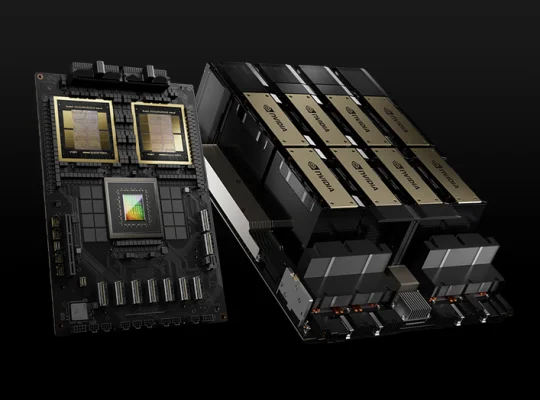NVIDIA’s Blackwell GPU architecture represents a monumental leap over its previous generations, particularly Hopper (H100/H200) for data centers andAda Lovelace (RTX 40 series) for consumer/workstation graphics. The primary focus of Blackwell is to accelerate the next era of Artificial Intelligence, especially large language models (LLMs) and generative AI, while also pushing boundaries in professional visualization and scientific computing.
Here’s a detailed comparison:
Blackwell vs. Hopper (Data Center AI/HPC)
Blackwell is the direct successor to Hopper and aims to address the escalating demands of trillion-parameter AI models.
Key Architectural & Performance Improvements:
Transistor Count:
- Blackwell (B200): ~208 billion transistors (dual-die design, each ~104 billion).
- Hopper (H100/H200): ~80 billion transistors (monolithic die).
- Advantage: Blackwell has over 2.5x more transistors, enabling significantly more processing power.
Manufacturing Process:
- Blackwell: Custom-built TSMC 4NP process (an enhancement of 4N).
- Hopper: TSMC 4N process.
- Advantage: 4NP offers higher transistor density and improved power efficiency.
Multi-Die Design:
- Blackwell (B200): NVIDIA’s first flagship GPU to use a dual-die (chiplet) design, with two large dies connected by a10 TB/s NV-HBI (NVIDIA High Bandwidth Interface). This allows for a much larger effective die size and higher yields.
- Hopper: Monolithic die.
- Advantage: Blackwell’s chiplet design overcomes the physical limits of a single reticle, enabling unprecedented scale.
Memory Capacity and Bandwidth:
- Blackwell (B200): Up to 192 GB of HBM3e VRAM with ~8 TB/s bandwidth.
- Hopper (H100): 80 GB of HBM3 with ~3.35 TB/s bandwidth.
- Hopper (H200): 141 GB of HBM3e with ~4.8 TB/s bandwidth.
- Advantage: Blackwell significantly boosts both memory capacity (up to 2.4x more than H100) and bandwidth (up to 2.4x more than H100), critical for fitting and processing larger AI models and datasets.
AI Compute Performance (PFLOPS):
- Blackwell (B200): Up to ~20 PFLOPS (FP4), ~9 PFLOPS (FP8), ~4.5 PFLOPS (FP16/BF16) per GPU.
- Hopper (H100): Up to ~4 PFLOPS (FP8), ~2 PFLOPS (FP16/BF16) per GPU.
- Advantage: Blackwell offers a 4.5x increase in FP4/FP8 performance over H100, and a substantial 2.25x increase at FP16/BF16. The introduction of FP4 precision is a major leap for inference.
Transformer Engine:
- Blackwell: Second-generation Transformer Engine with new micro-tensor scaling techniques for FP4 and MXFP6 data types. This doubles performance for next-gen AI models while maintaining high accuracy.
- Hopper: First-generation Transformer Engine, which introduced FP8 support.
- Advantage: Blackwell’s enhanced Transformer Engine is even more optimized for the demanding computations of LLMs and Mixture-of-Experts (MoE) models.
NVLink Interconnect:
- Blackwell: Fifth-generation NVLink, providing 1.8 TB/s bidirectional bandwidth per GPU (doubling Hopper’s). The NVLink Switch can scale to 576 GPUs with 130 TB/s of bandwidth.
- Hopper: Fourth-generation NVLink, providing 900 GB/s bidirectional bandwidth.
- Advantage: Dramatically improved inter-GPU communication for massive distributed AI training.
Grace Blackwell (GB200) Superchip:
- Blackwell: A revolutionary design combining two Blackwell GPUs with a Grace CPU on a single module. This significantly reduces data transfer bottlenecks between CPU and GPU (900 GB/s CPU-GPU connection via NVLink-C2C).
- Hopper: Relied on traditional PCIe connections between CPU and GPU, which is a bottleneck for data-intensive AI workloads.
- Advantage: The GB200 is a fully integrated compute node, offering unparalleled performance and efficiency for complex AI models.
Dedicated Decompression Engine:
- Blackwell: Yes, accelerates data processing by up to 800 GB/s (6x faster than Hopper). Crucial for data-intensive AI and analytics.
- Hopper: No dedicated engine.
- Advantage: Significantly speeds up data loading and preprocessing.
Secure AI & RAS (Reliability, Availability, Serviceability):
- Blackwell: Introduces Confidential Computing with TEE-I/O support for end-to-end encryption of data in use. Also includes an AI-powered RAS engine for predictive maintenance, maximizing uptime for large deployments.
- Hopper: Offered some security features, but less comprehensive.
- Advantage: Enhanced security and resilience for critical AI workloads.
Power Efficiency:
- Blackwell: While individual GPU TDP can be higher (e.g., 1000W for a B200 vs 700W for H100), theperformance per watt for large-scale AI is significantly better. NVIDIA claims a25x reduction in energy consumption for LLM inference (e.g., GB200 NVL72 vs H100).
- Advantage: More AI compute for less energy, reducing operational costs and environmental impact.
Overall Impact vs. Hopper: Blackwell delivers a2.5x to 30x performance boost (depending on workload and configuration) over Hopper, particularly for LLM training and inference. It enables the training of models with trillions of parameters that were previously infeasible.
Blackwell vs. Ada Lovelace (Consumer & Workstation Graphics/AI)
While Hopper was data center-focused, Ada Lovelace powered the RTX 40 series consumer GPUs. Blackwell’s consumer/workstation variants (like the RTX PRO 6000 Blackwell Workstation Edition and the upcoming RTX 50 series) will leverage much of the architectural advancements of its data center counterpart.
Key Architectural & Performance Improvements (for Gaming/Professional Viz):
Manufacturing Process:
- Blackwell (Consumer): TSMC 4NP process (refined 4N).
- Ada Lovelace: TSMC 4N process.
- Advantage: Similar to data center, a more optimized node for density and efficiency.
Transistor Count:
- Blackwell (e.g., GB202 for RTX 5090): Expected to be around 208 billion (dual-die approach for high-end consumer, or a larger single die than Ada Lovelace’s AD102).
- Ada Lovelace (AD102 for RTX 4090): ~76 billion transistors.
- Advantage: A massive increase, translating to more CUDA Cores, RT Cores, and Tensor Cores.
Memory:
- Blackwell (Consumer): Expected to move to GDDR7, offering significantly higher bandwidth. RTX PRO 6000 Blackwell features 96GB HBM3e VRAM.
- Ada Lovelace: Utilizes GDDR6X (high-end) and GDDR6.
- Advantage: GDDR7 provides a substantial bandwidth uplift, crucial for high-resolution gaming and complex professional datasets.
Tensor Cores:
- Blackwell: Fifth-generation Tensor Cores with enhanced support for AI precisions (including FP4 and MXFP6).
- Ada Lovelace: Fourth-generation Tensor Cores with FP8 support, enabling DLSS 3.
- Advantage: Blackwell’s Tensor Cores are more powerful and versatile for AI-driven features like DLSS 4 with Multi Frame Generation and Neural Shaders.
RT Cores (Ray Tracing):
- Blackwell: Fourth-generation RT Cores, with new features like “Triangle Cluster Intersection Engine” for Mega Geometry and “Linear Swept Spheres” for more detailed ray tracing (e.g., hair).
- Ada Lovelace: Third-generation RT Cores with Shader Execution Reordering (SER).
- Advantage: Improved ray tracing performance and efficiency, allowing for more complex and realistic lighting.
Neural Shaders:
- Blackwell: Introduces dedicated “Neural Shaders” for AI-powered rendering techniques, allowing for more complex effects and geometry generation using neural networks.
- Ada Lovelace: Relied on Tensor Cores for AI rendering features like DLSS 3.
- Advantage: A more direct and efficient approach to neural rendering.
DLSS:
- Blackwell: Expected to support DLSS 4 with Multi Frame Generation, further enhancing frame rates by leveraging more advanced AI.
- Ada Lovelace: Introduced DLSS 3 with Frame Generation.
- Advantage: Continual improvements in AI-upscaling and frame generation.
Connectivity:
- Blackwell (Consumer): Expected to be the first consumer GPUs withPCIe 5.0 and full support forDisplayPort 2.1 UHBR20 (80 Gbps).
- Ada Lovelace: PCIe 4.0 and DisplayPort 1.4a.
- Advantage: Future-proofed connectivity for faster data transfer and higher resolution/refresh rate displays.
IPC (Instructions Per Clock) in Gaming:
- Early benchmarks suggest that Blackwell, on an IPC basis forrasterized gaming, shows only a~1% IPC advantage over Ada Lovelace. Ray tracing IPC uplift also appears minimal.
- Advantage: The primary gaming performance gains from Blackwell will likely come from increased core counts, higher clock speeds, and the advancements in DLSS 4/Neural Shaders, rather than raw per-clock efficiency in traditional rasterization. This suggests NVIDIA heavily prioritized AI compute for the Blackwell generation.
Overall Impact vs. Ada Lovelace: For gaming, Blackwell’s improvements will come from higher transistor counts (more cores), faster memory (GDDR7), and significant advancements in AI-powered features (DLSS 4, Neural Shaders). For professional visualization, the increased VRAM, AI performance, and enhanced RT cores will offer substantial benefits.
In summary, NVIDIA Blackwell represents a strategic pivot towardsAI-first design, leveraging a multi-die architecture and specialized engines to deliver unprecedented performance, particularly for generative AI and LLMs. While it brings significant gains to professional visualization and will undoubtedly boost consumer gaming performance, its core revolution lies in its capability to scale AI supercomputing to new heights.�















